Angkor Wat Virtual Challenge
The Angkor Wat virtual challenge is a short one. At only 20 miles (32.2 km), it is a nice palate cleanser after the North 500. This path takes me through the magnificent remains of the Khmer civilization in the verdant jungles outside of Siem Reap, Cambodia. The ornate temples are the ultimate expression of Khmer genius and are considered by many to be one of the wonders of the world.
I spent a month visiting Vietnam and Cambodia in 2006. and ever since then, I have dreamed of returning. For a brief moment, I even imagined building a home there, but my complete lack of skills with a tonal language seemed like a real barrier.
Inside the Bayon, I experienced something that was as close to magic as my mind can embrace. An incredible sense of peace and connection filled me, pushing out the endless mental chatter inside my skull. I was connected and quiet in a way that I haven’t come close to since that day, and I really hope I can make it back there one day.
The Bayon was the last state temple to be built at Angkor, and it is the only Angkorian state temple to be built primarily to worship Brahma. When it was first built, it was a Mahayana Buddhist temple, the Bayon was the centrepiece of Jayavarman VII’s massive program of monumental construction and public works, and from each of the four cardinal directions, roads lead to this at the centre.
What pulled me in at first were the outer wall galleries featuring a series of bas-reliefs. Unlike the grand theological stories depict in the main temple of Angkor Wat, here I could see everyday life of the Angkorian Khmer. People were cooking, cleaning, farming, hunting, playing games, and just generally living their lives. People like myself were just doing their thing. Then, after deeply grounding me, rooting me in history, I reach the inner temple, surrounded by those serene faces. Every which way I turn, they gaze upon me as if everything was going to be okay, now and forever. I went from feeling comforted by the home life of the ancient Khmer to feeling certain that everything was the way it should be. I could just breathe.
I really want to get back there, to see if I can feel that one more time.
A New Reward
This challenge is the first one where I had the opportunity to have my distance count towards stopping ocean plastic, rather than planting trees. The Conqueror Virtual Challenge will donate toward planting a tree or stopping 10 bottles from entering the ocean for every 20% of the challenge I complete.
Up until now, the only option was tree planting, so I decided to try the new option for Angkor Wat. By the end of the challenge, I have stopped 50 bottles from entering the ocean. That’s not that impressive on my own, but it will be interested to see what can be achieved as a community.
After this, I’m likely to revert to having my progress markers plant trees, but I think it was fun to have a choice about how I wanted to improve the world while I worked to stay active enough to stay in this world a bit longer.
Postcards
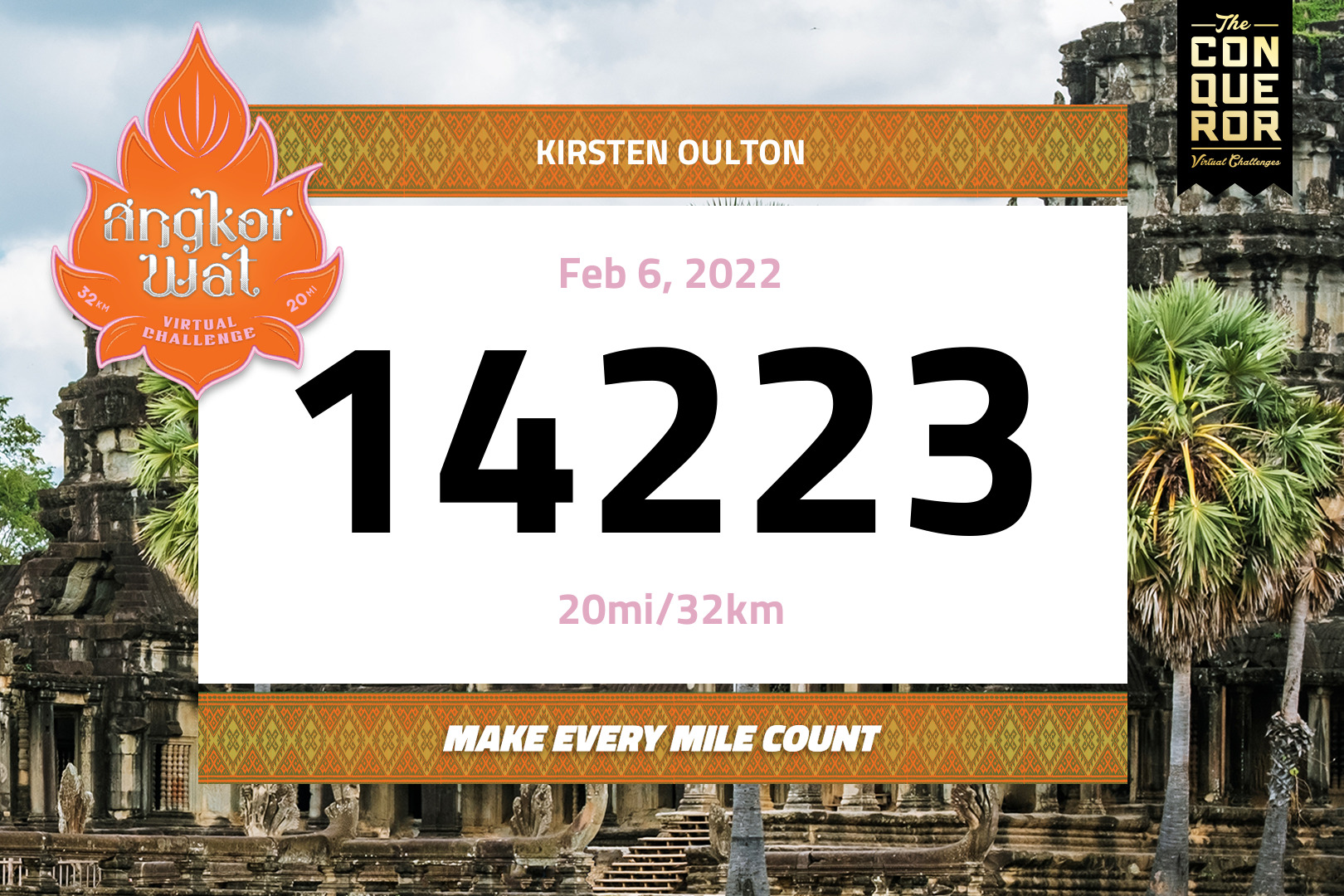
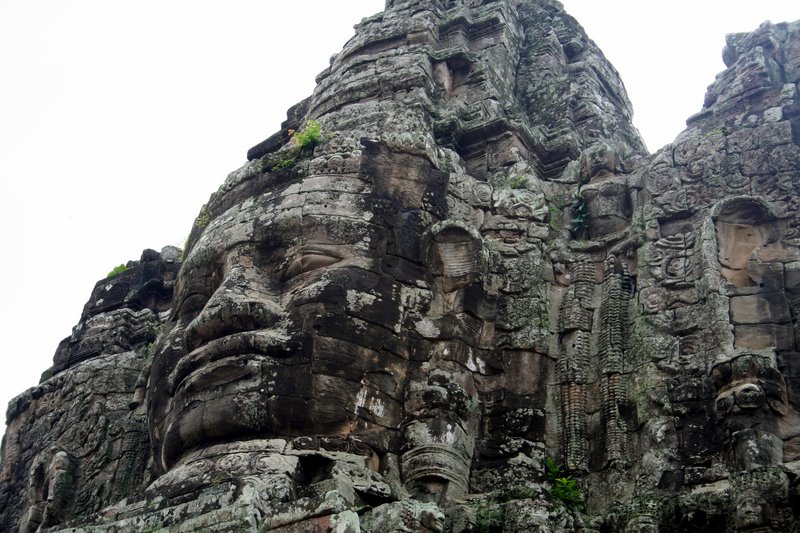
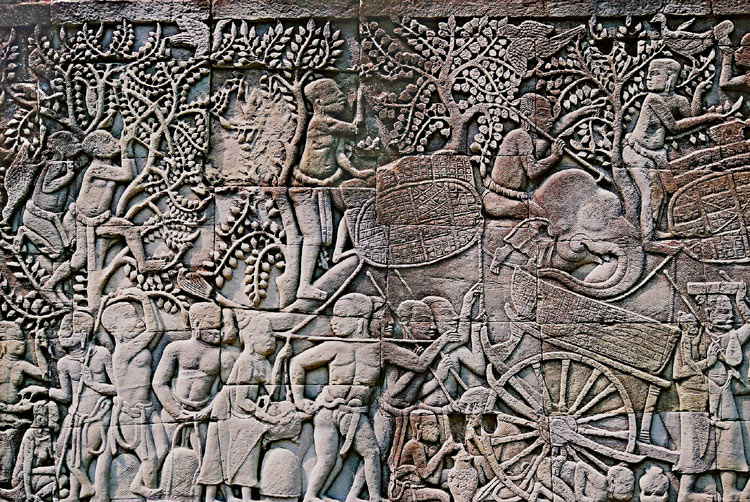

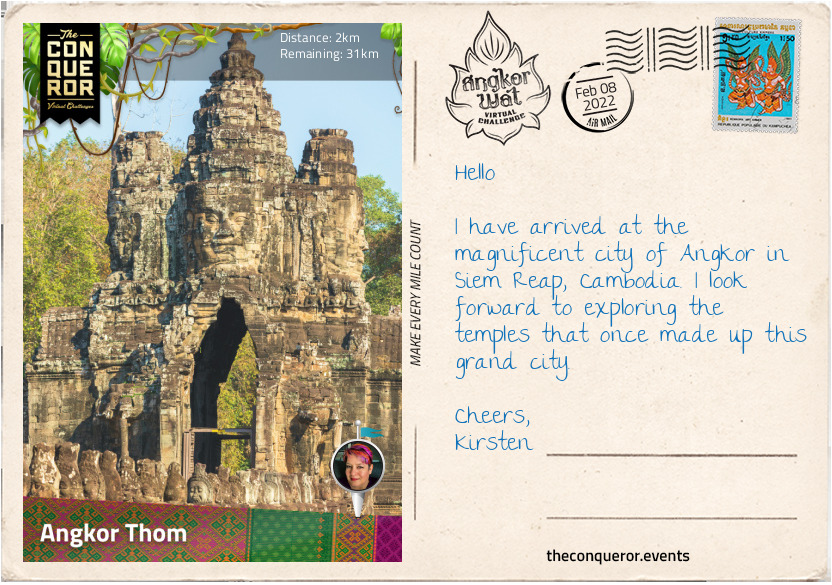
The medieval city of Angkor once served as the capital of the Khmer Empire, the indigenous people of Cambodia. Only 3mi (5km) east of Siem Reap Airport, it is very closely located and easily accessible. A thriving ancient megacity, at its peak it housed up to one million residents and contained several hundred temples with over 70 of them found inside the core of the city.
The temples were built over a period of 300 years, first dedicated to Hinduism and later to Buddhism. King Jayavarman II, the first king of the unified country circa 9th century, declared himself a Devaraja (God-King) and as such built himself temples for king-worship. Although very little remains of his structures, Jayavarman set the ground for succeeding kings to follow.
Believing that the mountain was the centre of the world and a link between heaven and earth, the temples were built to resemble mountain-like structures with tall, tapering towers. By the end of the building period in the 12th century Angkor was the largest city in the world.
After repeated invasions from the Thai in the west, in 1432 the Khmer moved the capital to Phnom Penh and Angkor was abandoned. Over the following centuries the city was swallowed by the jungle and disappeared until 1860 when naturalist Henry Mouhot, in search of exotic insects, was cutting his way through the depths of the jungle and came upon the city.
Teams of archaeologists descended upon Angkor to study it until the mid-20th century when decades of political unrest left the city neglected. In the 1990s preservation efforts resumed and in 1992 Angkor was designated a UNESCO World Heritage Site.
I am standing at the Victory Gate within Anghor Thom and I imagine, as lore tells it, the King sending his army through the gate into battle and upon victory welcoming their return. The elaborate arched gate is adorned with four large heads, each facing a cardinal direction, representing gods and demons. At the inner corners of the gate are sculptures of three-headed elephants. Through the gate is a path lined with statues of gods and demons holding onto a seven-headed serpent known as Naga. Just as the army departed into battle centuries ago, I too began my journey heading to the famed Ta Prohm temple that’s been enveloped by giant tree roots.
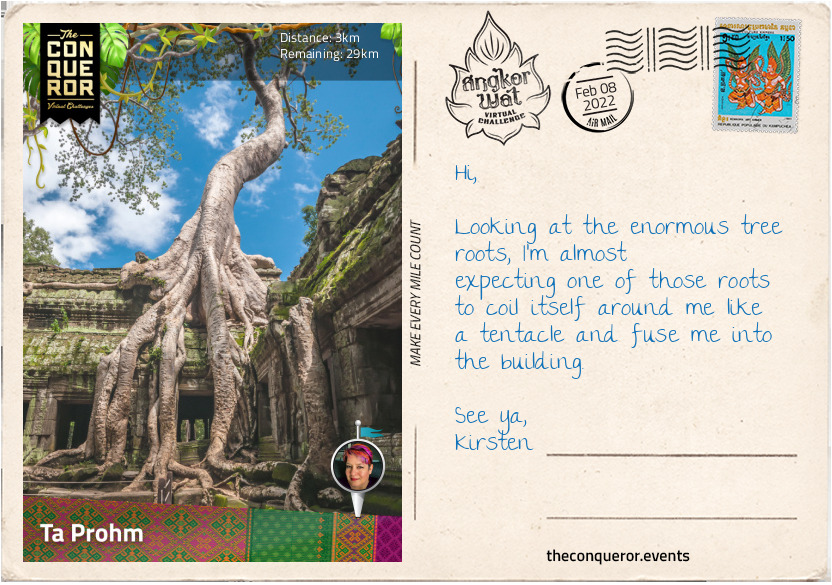
It was with great anticipation that I arrived at Ta Prohm temple. Possibly the most photographed temple in Angkor due to its unique appearance and subsequent rise to fame when it was used as a location setting for the 2001 Tomb Raider feature film. It’s not every day that you see trees growing out of ruins but that’s exactly what the jungle did during Angkor’s dormant centuries.
Ta Prohm was built by King Jayavarman VII around the late 12th century in honour of his family. He was the most prolific Khmer builder, constructing hundreds of monuments in as little as 40 years. The complex with the temple at its centre is made up of five wall enclosures. The outer wall is significantly larger and surrounded by a moat. Much of the internal space is now forested but this area once teemed with life when the complex had as many as 12,000 people living within its walls.
The three inner enclosures are galleried. With a low roofline, the interior passageways are very dark with little light filtering through the windows from outside. Some of the external walls have carved decorations of deities, meditating monks and temple guardians.
When restoration works began on the complex it was decided to leave it untouched allowing the trees to co-exist with the buildings they have grown over. Whilst it provides a fascinating view, the concerns are that the trees weigh heavily upon these fragile buildings. Although conservationists have added iron supports in some of the passageways, many of the ceilings in unprotected sections have collapsed under the weight.
Wooden walkways have been installed to protect the temples and as I walked around the complex I marvelled at the huge trees, snaking their roots along the temples’ roofline, spilling down the side like a fan. As nature strangles the narrow passageways it lets it be known that at any time it can reclaim itself and anything within it.
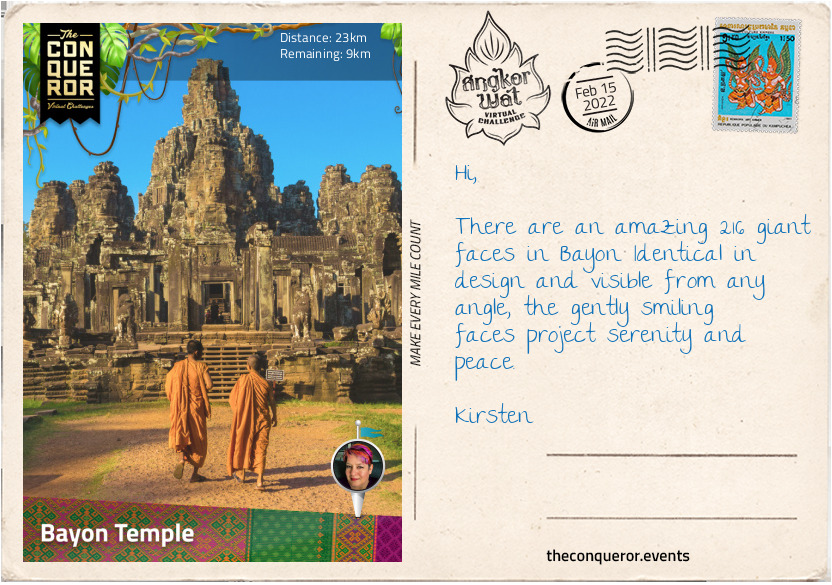
Exiting Ta Prohm through its eastern gate, the next 9mi (14km) was spent walking through the countryside, past rice fields, ruined temples and reservoirs heading towards Preah Khan temple.
Preah Khan was built by Jayavarman VII in honour of his father. Just like Ta Prohm it has been left with trees and vegetation growing out of the ruins with only stabilisation works undertaken. The highlight here was the two-storied building supported by numerous circular columns. No other building like it exists within Angkor. Intricately built, no one knows its purpose and although I’d like to imagine it as a library, it is speculated that it might have been a granary.
A mile later, I re-entered Angkor Thom through its northern gate. The largest complex of all the temples, it has an 8 mi (13 km) perimeter wall with five gates, surrounded by a moat. Within its walls are several magnificent stone temples and the beautifully carved Terrace of the Elephants. The 1150ft (350m) long terrace was used as the King’s viewing and ceremonial platform. The detailed elephant reliefs run along the sides of a staircase that is flanked by elephant trunk carvings and lion sculptures atop it.
In the centre is the splendid yet tightly packed Bayon Temple. Built as a Buddhist temple it also has elements of Hindu iconography. There are four giant faces embedded on each of the 54 towers rising from the galleried enclosures and upper terrace. It is theorised that the face is meant to depict Buddha but given its arrangement of four faces per tower others argue that it is the face of Brahma, a Hindu God, who according to ancient texts is meant to be shown with four heads. Many scholars also see a striking resemblance to King Jayavarman VII, the builder. With different schools of thought, some concluded that the theories need not be mutually exclusive. Jayavarman was a Buddhist but he followed the God-King traditions set before him by his Hindu predecessors.
Bayon was the last temple built in Angkor. After Jayavarman’s death in the early 13thC. many other building projects were met with limited success. Bayon Temple marked the end of monument building even though the capital continued to carry on until its final demise.
Standing in the temple’s presence, tranquillity came to mind. It was quiet and calm as if the faces were emitting a peaceful energy. The crowds were moving softly, lots of nooks presented themselves for peaceful contemplation. I stopped here for a while immersing myself in some stillness and mindfulness.
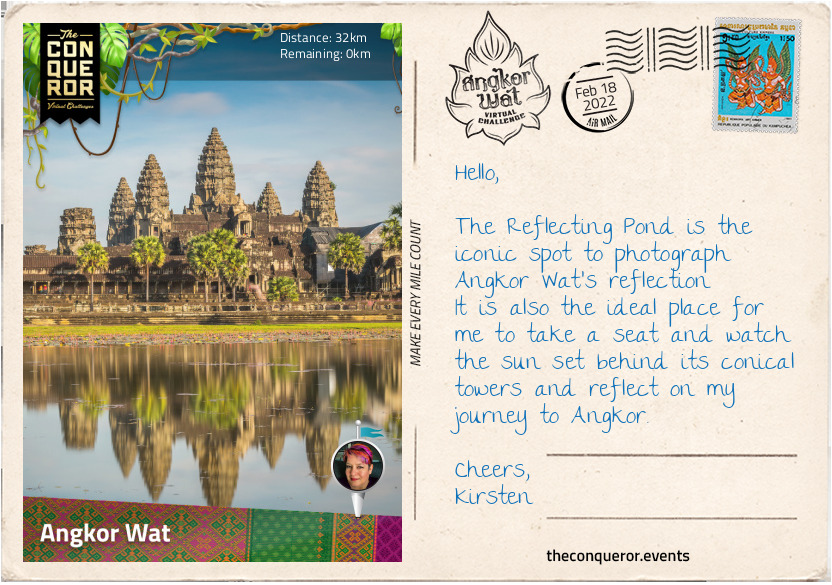
Finally, I arrived at the most significant complex on my journey, Angkor Wat, the largest religious monument in the world. Everything about this temple was carefully thought out, from the moat surrounding it, the architectural design, the geographical position and its purpose, in one word Angkor Wat is a masterpiece. It is the Khmer Empire’s greatest achievement and Cambodia’s crown jewel.
Built in the first half of the 12th century as a Hindu temple and mausoleum for King Suryavarman II, the complex covers an area of 400 acres, separated from the rest of the city by a moat that is 650ft (200m) across. This beautiful lake-like moat has a very important role in the survival of Angkor Wat. The weight of the water pushes against the earth and structure like a retaining wall, keeping Angkor Wat from collapsing. It is a symbiotic relationship which the architects intentionally planned when they designed this megastructure.
The architects wanted a dramatic and visually stunning structure visible from a long way away. They achieved that with a lengthy causeway allowing the grandeur of the temple to slowly unfold as it is approached.
Crossing the massive moat, I entered the main grounds through the central portal of the outer wall and found myself on the Terrace of Honour with stone balustrades decorated with sculptures of the serpent Naga. To take in the expanse of Angkor Wat, I took a northbound perimeter walk, heading east and slowly winding my way towards the centre.
Passing the Reflecting Pond, I entered the concentric gallery through a handful of stairs and experienced the first of many wall carvings that formed military, mythological and daily life stories. The most iconic was the 160ft (49m) long relief known as the Churning of the Ocean Milk, a Hindu story portrayed as a tug-of-war between good and evil.
More than 2,000 statues of apsaras (female spirits) can be found in the temple, each one highly detailed showing masterful craftsmanship and the artists’ desire to bring the sculptures to life.
Entering the central terrace, I was met with the exceedingly steep, eye-watering, set of stairs that led to the final terrace. It was made up of five conical towers that represent the peaks of Mount Meru, home of the Hindu Gods. This final climb ended at dizzying heights but was worthwhile for the aerial views of the complex and surrounding jungle.
This brings me to the end of my journey. The city of Angkor is a remarkable testament to the Khmer Empire, its artisans and architects. It is also a reminder of the syncretic nature of its religion, as illustrated by the Hindu and Buddhist elements found in its architecture. The stone temples have endured for over 500 years and although extremely fragile, with ongoing conservation efforts I hope it will continue to endure for future generations.

